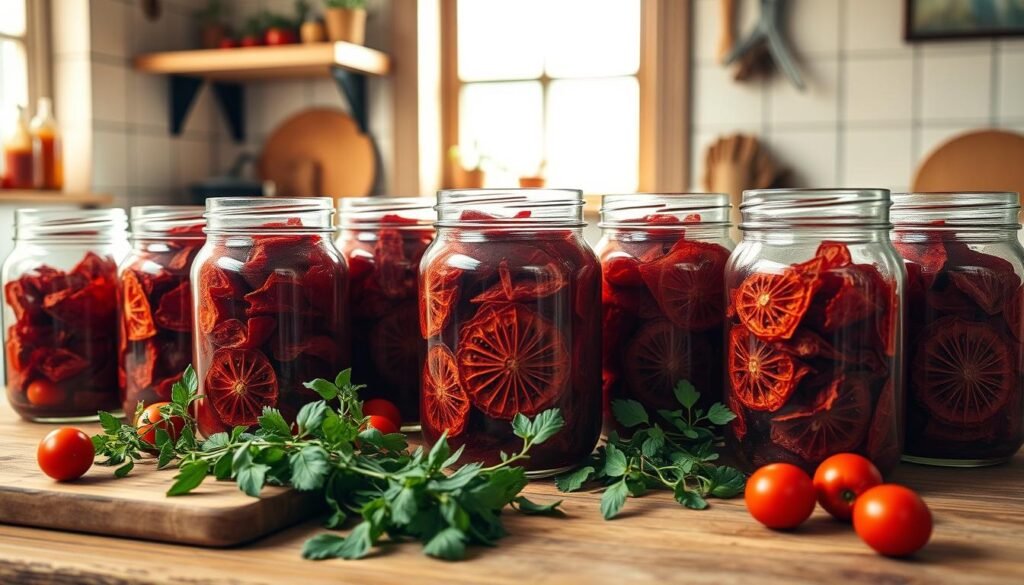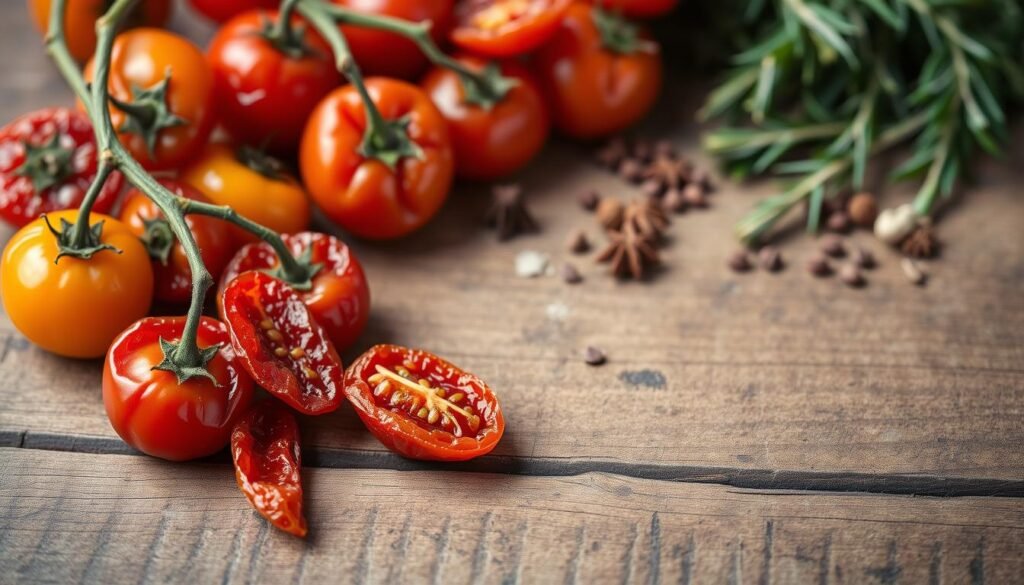Preserving your own food can save a lot of money. Dehydrating tomatoes is a great way to do this. It keeps their taste and nutrients, and saves space too.
When dehydrating tomatoes, you might wonder if you should peel them first. There are good points on both sides. Peeling can make the dried tomatoes smoother and less bitter. But, it’s time-consuming and can lose some nutrients. By learning this blog you will get answer of Should tomatos be peeled before drying in a food dehydrator or not.
Key Takeaways
- Dehydrating tomatoes can be a great way to preserve their taste and nutrients.
- Whether to peel the tomatoes before drying is a personal choice with pros and cons to consider.
- Leaving the skins on can result in a more nutrient-dense final product, but peeling can lead to a smoother texture.
- Properly preparing and slicing the tomatoes can help ensure an efficient drying process.
- Properly storing dehydrated tomatoes is crucial to maintain their quality and shelf life.
Whether to peel tomatoes before dehydrating depends on your needs. We’ll look into the benefits of dehydrating tomatoes next.
Table of Contents
The Convenience of Dehydrating Tomatoes
Preserving Tomatoes for Later Use
Dehydrating tomatoes is a great way to keep your garden’s bounty for winter. It’s easy, needs little effort, and saves space. Dehydrated tomatoes taste like they’ve been sun-dried and are good in many dishes.
Dehydrating tomatoes can cut their weight by up to 90%. This makes them great for saving space. Unlike canning or freezing, dehydrating is simple. You can store them in airtight containers for up to 6 months in a cool, dark place or longer in the freezer.
Dehydrated tomatoes are perfect for soups, stews, sauces, dips, and even homemade tomato jerky. Their strong flavor and small size make them a great addition to many dishes all year.
Dehydrating is a smart way to keep tomatoes fresh longer. It saves space and is good for many recipes. This method is a big help for those who love the taste of dried tomatoes.
Getting Started with Dehydrating Tomatoes
Preparing tomatoes for dehydration is easy. First, make sure your workspace, dehydrator, and tomatoes are clean. You’ll also need a sharp knife.
Any tomato can be dried, but some take longer. Slice the tomatoes to 1/4 to 1/2 inch thick. This helps them dry evenly. Place the slices on your dehydrator trays without overlapping.
- Wash and pat dry the tomatoes before slicing.
- Slice the tomatoes evenly, aiming for 1/4 to 1/2 inch thickness.
- Arrange the sliced tomatoes in a single layer on the dehydrator trays.
Getting ready is key to drying tomatoes well. Clean, slice, and arrange them carefully. This way, you’ll enjoy homemade tomato dehydration soon.
Preparing Tomatoes for Dehydration
Getting tomatoes ready for your dehydrator is easy. It makes tasty, long-lasting dried tomatoes. This is great for saving tomatoes or for easy dehydrated snacks.
Start by washing the tomatoes well. Then, take off the stems. Cut the tomatoes into slices or cubes. Smaller pieces dry faster.
- Smaller cherry tomatoes can be halved, while larger varieties can be quartered or cut into ¼-inch slices.
- Proper prepping helps the tomato skins for dehydrating by allowing for more efficient and consistent drying.
Some people peel tomatoes before dehydrating. But, you don’t have to. The skins dry well and add flavor. If you want to peel, blanching in boiling water helps.
“Dehydrated tomatoes should be hard when completely dried, and can last upwards of a year when properly dried and stored.”
Now, your tomatoes are ready for dehydration. They’ll be tasty, long-lasting, and perfect for many dishes.
should tomatos be peeled before drying in a food dehydrator
Dehydrating tomatoes raises a question: should they be peeled first? I never peel them and the taste is great, even with skins on.
Some people have mentioned the skin on their dried tomatoes. But, it’s common and doesn’t hurt the taste. Leaving the skins on can even make the tomatoes more nutritious and chewy.
The University of Florida and the University of Georgia say to peel ripe tomatoes before drying. The skin can get tough and leathery. But, cherry, grape, and plum tomatoes don’t need peeling.
For drying, plum, oval, or pear-shaped tomatoes work best. They dry evenly because they have more flesh than skin. To dry them, use a dehydrator or oven. Turn the slices after 2 to 4 hours. It takes 8 to 12 hours at 145°F (63°C).
Whether to peel or not peel tomatoes is up to you. Peeling makes them smoother and less chewy. But, leaving the skins on adds texture and is easier.
Dehydrator Settings and Timing
Dehydrating tomatoes needs careful attention to temperature and time. The right dehydrator settings are crucial for the perfect dried tomato. Set your dehydrator to 125°F (52°C) for the best results.
The drying time for tomatoes changes based on size, type, and humidity. Generally, it takes 8-14 hours. But, if your tomatoes are bigger or thicker, they might need 20-24 hours.
Optimal Temperature and Duration
Keep an eye on the drying process and adjust as needed. Check the tomatoes often to see if they’re dry enough. You might want them slightly chewy or very crisp. By keeping the temperature steady and adjusting time, you’ll get perfect dehydrated tomatoes.
| Dehydrating Condition | Time |
|---|---|
| Tomato Skin Dehydration in Dehydrator | 8-12 hours |
| Tomato Skin Dehydration in Oven | 2-3 hours |
| Tomato Dehydration in Dehydrator | 6-8 hours at 140°F |
“The key to perfect dehydrated tomatoes is maintaining the right temperature and monitoring the drying time closely.”
Conditioning and Storing Dehydrated Tomatoes
Keeping the taste and texture of your dehydrated tomatoes fresh is important. A simple conditioning step can help them last longer. After drying, it’s time to get them ready for storage.
Put the dried tomatoes in an airtight container, like a mason jar or resealable bag. Shake the container gently every day for a week. This helps any leftover moisture spread evenly, stopping mold or bacteria from growing.
Watch the container closely during this time. Look for any signs of moisture. If you see dampness, dry the tomatoes again in the dehydrator. This makes sure your stored dehydrated tomatoes stay good for 6 to 12 months in a cool, dry spot.
Storing them right is key to enjoying your preserved tomatoes for months. By following this easy conditioning and storing in an airtight container, you can enjoy summer flavors all year.

Enhancing Flavor with Seasonings
Dehydrated tomatoes are great for adding flavor to many dishes. Try marinating them in olive oil and herbs like basil and oregano. This makes them taste amazing and adds variety to your cooking.
For a Mediterranean taste, sprinkle some spices over the tomatoes. Use dehydrator tomato recipes and sundried tomatoes for a rich flavor. They’re perfect for pasta, soups, and croutons. Try different mixes to find your favorite taste.
Want a smoky flavor? Coat the tomatoes with a mix of smoked paprika, chili powder, and brown sugar. It’s a tasty snack on its own or in your favorite dehydrator tomato recipes.
There are so many ways to make dehydrated tomatoes taste great. Add herbs and spices to make them a tasty addition to many dishes. They’re perfect for pasta sauces and sundried tomatoes in salads.
Don’t be afraid to try new flavors. Experimenting with seasonings can make your dishes even better. With a bit of creativity, you can take your dehydrated tomato dishes to the next level.
Versatile Uses for Dehydrated Tomatoes
Dehydrated tomatoes are a great addition to your kitchen. They’re not just for snacking. They can make your dishes taste better and feel more interesting.
Creative Culinary Applications
Try adding them to your winter stew or pasta sauce. They add a rich flavor. Use them in salad dressings for a tangy taste. Or, grind them into a seasoning for grilled meats and veggies.
Rehydrate them to make tasty sauces. These sauces are perfect for dipping bread or topping chicken and fish. The uses are endless.
Use them on popcorn for a tasty snack. Or mix them into bread dough for extra flavor. Whether you’re a pro or new to cooking, these tomatoes are a great find.
| Culinary Uses | Benefits |
|---|---|
| Stews and Sauces | Adds depth of flavor and texture |
| Salad Dressings | Provides a tangy, sundried tomato taste |
| Dry Rubs and Seasonings | Enhances the flavor of meats and vegetables |
| Sauces and Spreads | Rehydrates easily for creamy, flavorful results |
| Baked Goods | Adds texture and a burst of tomato jerky flavor |
Dehydrated tomatoes are great for many dishes. They add flavor and texture. They’re a must-have for anyone who loves cooking.

Time-Saving Convenience
Dehydrating tomatoes saves a lot of time. You can keep a big batch of tomatoes ready all year. This means you don’t have to buy, prepare, and cook fresh tomatoes over and over.
Tomato dehydration is easy and keeps tomatoes fresh for a long time. Dried tomatoes are much lighter and take up less space. This makes them easy to store and keep for later use.
“Drying food is a method of preservation that removes enough moisture so bacteria, yeast, and molds cannot grow. Dehydrators produce the best quality dried foods compared to other methods.”
Having dried tomatoes ready can make cooking quicker. They’re great for making sauces or adding flavor to dishes. This makes dehydrating tomatoes a big help in the kitchen.
Maximizing Shelf Life
Dehydrated tomatoes can last up to 18 months if stored right. Keep them in an airtight container or jar with olive oil in the fridge. This way, you can enjoy your preserved tomatoes for a long time.
- Dehydrated tomatoes typically lose about 95% of their mass when dried.
- The shelf life of dried tomatoes is approximately 18 months when stored in ideal conditions.
- Drying tomatoes in an electric dehydrator takes approximately 10-18 hours at around 140°F, depending on humidity levels.
Conclusion
Dehydrating tomatoes has been fully discussed, including if you should peel them first. I found that leaving the skins on doesn’t hurt the taste or quality. This makes the drying process easier and keeps the tomatoes’ flavor intact.
Dehydrating tomatoes is a great way to save space and enjoy their flavor all year. You can use them in many dishes, like making tomato chips or adding to sauces and soups. This method is both fun and useful.
Peeling or not peeling tomatoes is up to you. But drying them is a good way to use up your tomatoes. By following the tips in this article, you can make tasty, healthy food for your meals.









